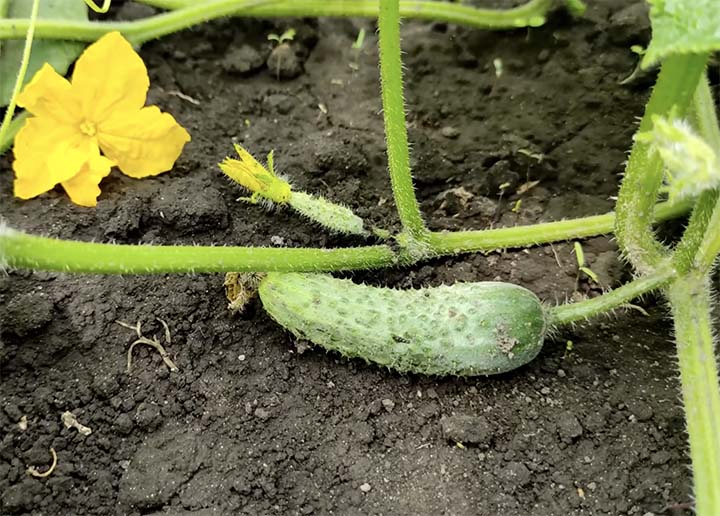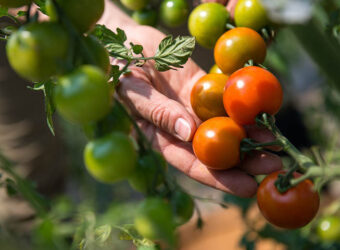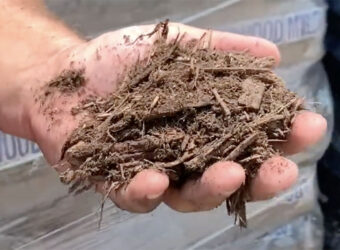Growing your own cucumbers is very satisfying. Unfortunately, I get lots of cucumbers and can’t eat them all fresh. Canning the cucumbers into pickles is a good way to preserve them for later use. Here is a guide to the best cucumber varieties to grow for making pickles. Some of them also make good eating when fresh.
What Are Pickling Cucumbers?
Pickling cucumbers are a group of cucumbers that stand up to the brine, cooking, and canning that are used when making pickles better than other cucumbers. Pickles should be crisp, not limp, and these varieties deliver that better.
What Makes Cucumbers Good For Pickling?
There are many varieties of pickling cucumbers. However, all pickling cucumbers have some similar characteristics.
- Thin skin so brine can penetrate
- Firm, dry flesh for crisper pickles
- Small size to fit in jars better
- Barrel shape to fill the jars better
Bush Versus Vine
Technically, all cucumbers grow on vines. Some of these vines can get six to eight feet long. However, not everyone has the space to grow vines that long. Bush cucumber varieties have a taller plant with vines that are less than three feet long. These are adapted well to growing in containers, hanging baskets, or small gardens, and many were bred for that purpose. I list whether a cucumber variety is a vine or a bush so you will know how much space the cucumber plant will take.
Top 9 Pickling Cucumber Varieties
Here are my picks for the best 9 pickling cucumbers.
1. Calypso

Type: Vine
Days to harvest: 52
Hybrid or Open Pollinated: Hybrid
Resistant to: Angular Leaf Spot, Anthracnose (A), Cucumber Mosaic Virus, Downy Mildew, Powdery Mildew, Scab
Harvest size: 3-6 inches
The Calypso cucumber produces cucumbers early and often. The heavy yield is medium green with white spines.
Pick when the cucumber is three to six inches and one inch in diameter. It has firm flesh and uniform cucumbers.
Calypso cucumbers only have female flowers, so you will need to plant a type of cucumber with male and female flowers with it to pollinate its flowers. Otherwise, you will not get any cucumbers.
You can get seeds for this cucumber at Urban Farmer, High Mowing Organic Seeds, and Amazon.
2. Boston Pickling

Type: Vine
Days to harvest: 55
Hybrid or Open Pollinated: Heirloom, Open Pollinated
Resistant to: Cucumber Mosaic Virus, Powdery Mildew
Harvest size: 2-6 inches
Boston pickling cucumbers are small, black-spined cucumbers. They are an heirloom variety.
These cucumbers have a high yield and are best picked when they are about four inches long. They are medium green and very cute.
Picked small, Boston pickling cucumbers can be used for slicing, too. The flesh is crisp and juicy.
In my area, Home Depot carries this type of cucumber plant. You can get seeds from Ferry-Morse, Urban Farmer, and Amazon.
3. National Pickling
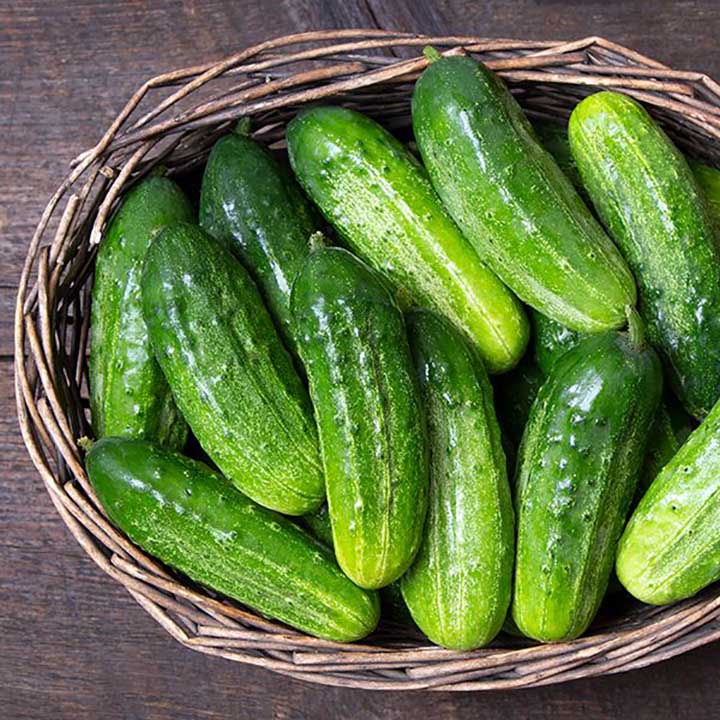
Type: Vine
Days to harvest: 52
Hybrid or Open Pollinated: Heirloom, Open Pollinated
Resistant to: Cucumber Mosaic Virus, Scab
Harvest size: 2-6 inches
National Pickling cucumbers are an heirloom variety developed by the National Pickle Packers Association, working with the Michigan Agriculture Experiment Station for commercial use. The blunt ends fill a pickle jar better than tapered ends.
These cucumbers are dark green with black spines. Pickle at two inches for gherkins, four inches for regular pickles, and six inches for giant dills. You can use these as slicers when they are four inches long, too.
Find seeds for National Pickling cucumbers at High Mowing Organic Seeds, Park Seed, and Amazon.
4. Wisconsin SMR 58

Type: Vine
Days to harvest: 55-60
Hybrid or Open Pollinated: Open Pollinated
Resistant to: Scab, Cucumber Mosaic Virus
Harvest size: 6-8 inches
Wisconsin SMR 58 cucumbers were developed by the University of Wisconsin in 1959. It grows well in the Midwest and other areas with short seasons.
The fruit is medium green, crisp, and sweet. If kept picked, Wisconsin SMR 58 will bear lots of cucumbers all season long. It is a favorite of picklers because the plants are such heavy producers.
Find seeds for the Wisconsin SMR 58 at Urban Farmer, West Coast Seeds, and Amazon.
5. H-19 Little Leaf
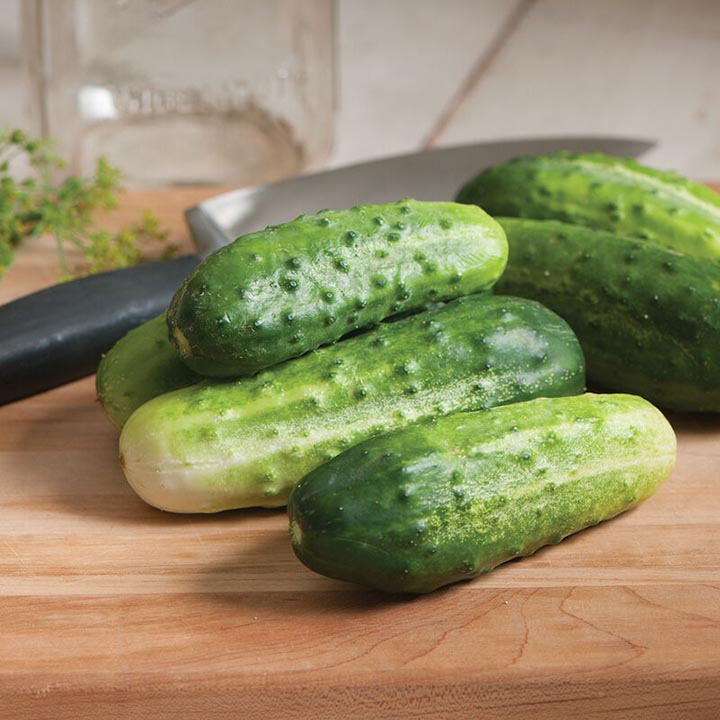
Type: Bush
Days to harvest: 58
Hybrid or Open Pollinated: Open Pollinated
Resistant to: Angular Leaf Spot, Anthracnose, Scab, Cucumber Mosaic Virus, Powdery Mildew
Harvest size: 3-4 inches
H-19 Little Leaf cucumbers do indeed have leaves half the regular size. They have cucumbers that are a bright emerald green with white spines. These cucumbers not only pickle well, but they are also good to eat fresh.
Growing on multiple vining branches, the cucumbers only have female flowers, so produce more cucumbers than one with male and female flowers. This cucumber is self-fertile. It was developed by the University of Arkansas in 1991.
Find seeds for the H-19 Little Leaf at Johnny’s Selected Seeds, High Mowing Organic Seeds, and Amazon.
6. Pick A Bushel
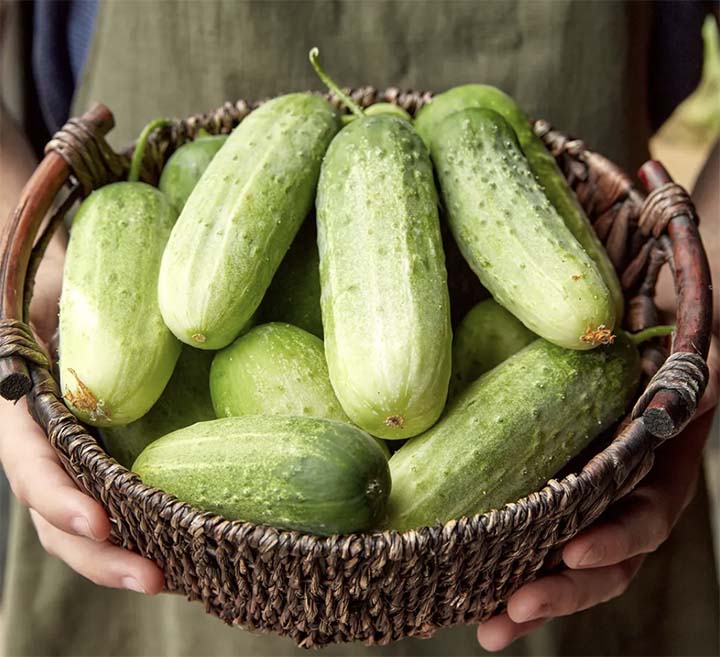
Type: Semi-Bush
Days to harvest: 50
Hybrid or Open Pollinated: Hybrid
Resistant to: Cucumber Mosaic Virus, Mottle Mosaic Virus, Scab, Watermelon Mosaic Virus (Strain 2)
Harvest size: 3-6 inches
Pick A Bushel cucumbers were a 2014 All-America Selections Regional Award Winner for Heartland and Great Lakes. While these cucumbers do well in warmer areas, they shine the best in the Midwest and places with short seasons.
Plants have 10-20 cucumbers that grow up to six inches long. They have white spines and a crisp flesh. Pick A Bushel cucumbers are good as slicers, too.
Find seeds for the Pick A Bushel cucumber at Park Seed, Burpee, and Amazon.
7. Bush Pickle

Type: Bush
Days to harvest: 50
Hybrid or Open Pollinated: Hybrid
Resistant to: Scab, Cucumber Mosaic Virus
Harvest size: 3-4 inches
Bush Pickle cucumbers are one of the earliest pickle varieties. This green, black-spined pickle grows in only 50 days. It produces large numbers of sweet, crisp 4-5-inch-long cucumbers, perfect for the canning jar.
Bush Pickle was bred to be grown in containers, so it is very compact. The vine of this plant grows to three feet tall. It would grow great in a large hanging basket where the branches can trail over the side.
You can get seeds for Bush Pickle cucumbers at True Leaf Market, NeSeed, and Amazon.
8. Eureka
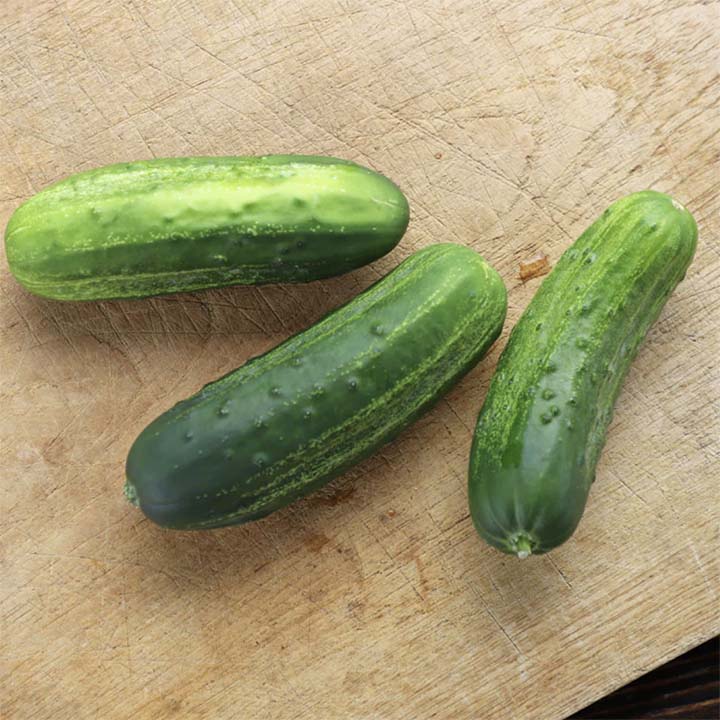
Type: Vine
Days to harvest: 57
Hybrid or Open Pollinated: Hybrid
Resistant to: Angular Leaf Spot, Anthracnose (Co:1,2), Cucumber Mosaic Virus, Downy Mildew, Powdery Mildew, Papaya Ringspot Virus, Scab, Watermelon Mosaic Virus (Strain 2), Zucchini Yellow Mosaic Virus
Harvest size: 1 ½-5 inches
Eureka cucumbers are resistant to more diseases than any other cucumber. If you have had trouble growing cucumbers in the past due to disease problems, this is the cucumber for you. Not only does it make a great pickling cucumber, it is also great as a slicing cucumber, too.
This cucumber is dark green with white spines and firm flesh. It makes sweet gherkins at 1 ½ inches long or regular pickles at five inches long. Eureka produces both male and female flowers, so you can plant one plant without worrying about it setting fruit.
Get Eureka seeds at Park Seeds, Willhite Seed, Inc., and Amazon.
9. Picklebush
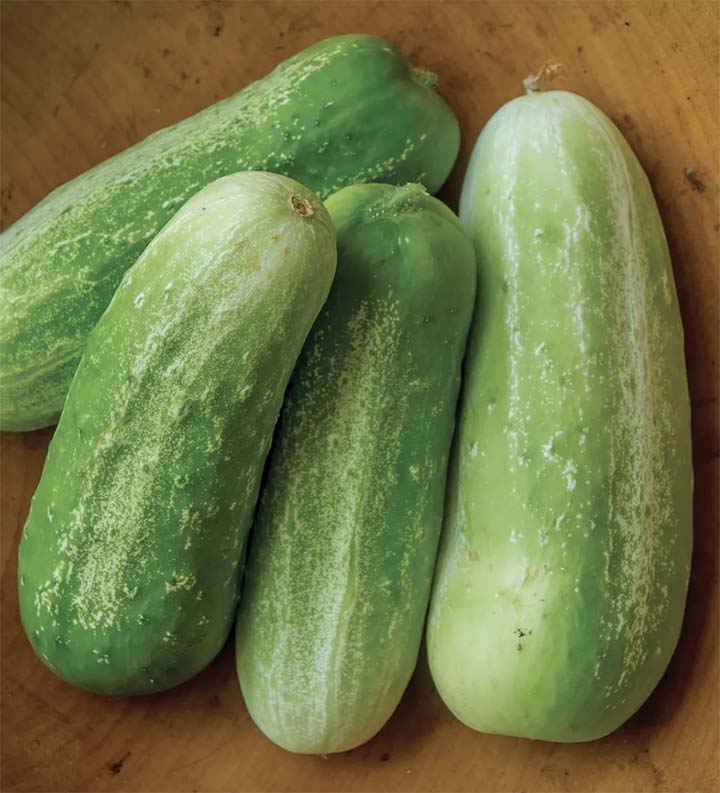
Type: Bush
Days to harvest: 52
Hybrid or Open Pollinated: Open Pollinated
Resistant to: Cucumber Mosaic Virus, Powdery Mildew
Harvest size: 4 1/2 inches
Picklebush cucumbers were bred by Burpee to grow in a container or tight space. They have fruit with the classic pickle look, dark green with paler green stripes and white spines.
You can harvest these pickles small or allow them to grow a full 4 ½ inches long and 1 ½ inches in diameter for large, classic dill pickles. The small vines only grow to be two feet long but are unbelievably productive.
Picklebush cucumbers grow well almost anywhere in the United States. Find seeds at Burpee, Walmart, and Amazon.
Trellising Pickling Cucumbers
In order to get straight pickles for your cucumbers, it is very important you trellis your cucumber vines. Even bush vines benefit from a three-foot trellis. A trellis is a pole, stake, or other straight structure that you train your vine to climb. When attaching your vines to the trellis, use stretchy plant tape. String will also work if you do not pull it too tight. Wire will cut the vine in half and kill it. Wrap the vine and trellis with one loop of the tape, leaving about an inch of slack. This gives the vine room to grow. Your cucumbers will hang straight down and grow nice and straight, so they fit in the jar properly. I have found that trellised cucumbers have fewer diseases, and the fruit is not bothered as much by insects. I trellis all my cucumber vines.
Succession Planting
Pickling cucumbers do not bear fruit as long as slicing cucumbers. They tend to have their cucumbers over two or three weeks, especially the older pickling varieties. Some of the newer hybrids bear fruit all season. If you keep your cucumbers picked every day or two, they will bear fruit longer. You can also plant several plants about three weeks apart to extend the time you have cucumbers all the way to the first frost.
How To Pickle Cucumbers
Cucumbers are pickled with a combination of spices, salt, vinegar, water, and heat. The spices add flavor, while the salt brine and vinegar keep bad bacteria from growing in the pickle solution. Heat sterilizes the mixture to prevent food-borne illness. It is very important to follow pickle recipes closely and not to change the proportion of salt, vinegar, water, and cucumbers. Otherwise, your pickles could make you sick. Because pickles are acidic, you can them using the water bath method, so you do not have to use a pressure cooker. Be sure to adjust the time you process your cucumbers to the sea level where you live. The higher the elevation, the longer it takes to process a batch. The extra time is important, so don’t skimp on it.
Pickle Cucumber Recipes
Traditional pickles came in several flavors: dill, sweet, sour, bread and butter, and fermented. Many Extension services offer pickle recipes. Expect to use six to eight pounds of cucumbers for a typical recipe. Here is an example of a dill pickle recipe.
Yields seven pints. Recipe from North Caroline Extension.
- 8 lbs of 3-to 5-inch pickling cucumbers
- 2 gallons water
- 2 cups canning salt, divided
- 1 1/2 quarts vinegar
- 1/4 cup sugar
- 2 quarts water
- 2 tablespoons mixed pickling spice
- 3 to 5 tablespoons whole mustard seed (1 to 2 tsp. per pint jar)
- 14 heads fresh dill (about 2 heads per pint jar)
Wash the cucumbers and cut off the blossom end. Leave ¼ inch of stem attached to use as a handle on the pickle.
Dissolve the 1 ½ cups of salt in two gallons of water and pour over the cucumbers. Let stand for twelve hours before draining.
Mix the vinegar, ½ cup of the salt, sugar, and two quarts of water.
Add the pickling spices tied up in a clean white cloth to the solution. Heat the brine to boiling.
Fill the pint jars with cucumbers. Add one to two teaspoons of mustard seed and two heads of fresh dill to each jar. Pour in the brine, leaving ½ inch headspace.
Adjust lids. Process the pints for ten minutes if you live 0-1,000 feet above sea level, 15 minutes if you live 1,001-6,000 above sea level, and twenty minutes if you live over 6,000 above sea level.
I give recipes for dill, sweet, sour, bread and butter, and fermented pickles here.
In conclusion, pickling cucumbers come in the traditional vines and in bushes. Even bush cucumbers benefit from being trellised. Plant several plants three weeks apart to extend your harvest of cucumbers. The best vine pickling cucumbers are Calypso, Boston Pickling, National Pickling, Wisconsin SMR 58, and Eureka. Pick A Bushel cucumbers are good semi-vine cucumbers. H-19 Little Leaf, Bush Pickle, and Picklebush are the best bush pickling varieties. Turning your cucumbers into pickles is easy if you follow the directions exactly. Good growing.
